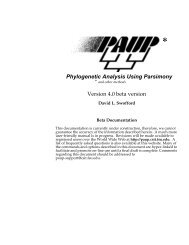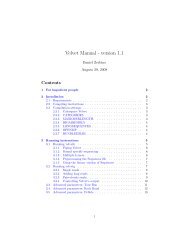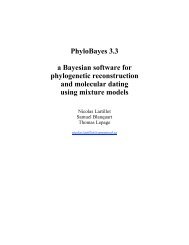BLAST Command Line Applications User Manual
BLAST Command Line Applications User Manual
BLAST Command Line Applications User Manual
You also want an ePaper? Increase the reach of your titles
YUMPU automatically turns print PDFs into web optimized ePapers that Google loves.
Page 20Here the input is hs_chr.mfa (-in hs_chr.mfa), enable parsing of sequence ids, specify themasking algorithm name (-masking_algorithm repeat) and its parameter (-masking_options“repeatmasker, default”), and ask for asn.1 output (-outfmt maskinfo_asn1_bin) to be saved inspecified file (-out hs_chr_mfa.asnb).<strong>BLAST</strong> Help <strong>BLAST</strong> Help <strong>BLAST</strong> Help <strong>BLAST</strong> Help5.2.2 Create <strong>BLAST</strong> database with the masking informationUsing the masking information data files generated in steps 5.2.1.1, 5.2.1.2, 5.2.1.3, and 5.2.1.4,we can create <strong>BLAST</strong> database with masking information incorporated.Note: we should use “-parse_seqids” in a consistent manner – either use it in both steps or notuse it at all.For example, we can use the following command line to apply the masking information, createdin step 5.2.1.2, to the existing <strong>BLAST</strong> database generated in 5.2.3:$ makeblastdb -in hs_chr -dbtype nucl -parse_seqids \-mask_data hs_chr_mask.asnb -out hs_chr -title \"Human Chromosome, Ref B37.1"Here, we use the existing <strong>BLAST</strong> database as input file (-in hs_chr), specify its type (-dbtypenucl), enable parsing of sequence ids (-parse_seqids), provide the masking data from step5.2.1.2 (-mask_data hs_chr_mask.asnb), and name the output database with the same basename (-out hs_chr) overwriting the existing one.To use the original FASTA sequence file (hs_chr.fa) as the input, we need to use “-in hs_chr.fa”to instruct makeblastdb to use that FASTA file instead.We can check the “re-created” database to find out if the masking information was addedproperly, using blastdbcmd with the following command line:$ blastdbcmd -db hs_chr -infoThis command prints out a summary of the target database:Database: human chromosomes, Ref B37.124 sequences; 3,095,677,412 total basesDate: Aug 13, 2009 3:02 PMLongest sequence: 249,250,621 basesAvailable filtering algorithms applied to database sequences:Algorithm ID Algorithm name30 windowmaskerAlgorithm optionsVolumes:/export/home/tao/blast_test/hs_chr<strong>BLAST</strong> <strong>Command</strong> <strong>Line</strong> <strong>Applications</strong> <strong>User</strong> <strong>Manual</strong>





